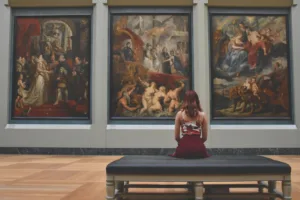
Buying Art with Both Heart and Strategy
Acquiring a painting today is no longer just about emotion it’s also a strategic investment in culture and creativity. In the dynamic world of contemporary art, collectors face an exciting but complex landscape, where abstract, figurative, and mixed-media works coexist and compete. To choose wisely, it’s essential to understand how to evaluate a painter’s market potential and artistic trajectory. Whether you’re a first-time buyer or a seasoned collector, this guide will help you decide which painter to buy and why.
Understanding an Artist’s Market Value
A painter’s value extends far beyond their talent. It’s shaped by recognition, career milestones, and participation in key exhibitions. Collectors should pay close attention to:
- Gallery representation: Artists exhibited in reputable galleries or featured in curated shows often have higher visibility.
- Museum presence: Institutional exhibitions and acquisitions by museums elevate long-term credibility.
- Critical recognition: Awards, reviews, and inclusion in art fairs or biennales can signal rising demand.
Before investing, take time to study the artist’s body of work, evolution, and critical reception. Those factors will reveal whether the artist’s market is stable, growing, or speculative. In short, the stronger the recognition, the safer the investment.
Styles and Mediums That Influence Market Trends
Not all art techniques are valued equally. The materials and methods chosen by a painter whether oil on canvas, watercolor, or mixed media directly affect their price point and appeal.
Current collector trends show strong interest in:
- Abstract and minimalist art: Valued for timeless appeal and versatility.
- Urban and street art: Continues to grow among younger buyers.
- Contemporary figuration: Balances modern aesthetics with emotional depth.
For a balanced portfolio, consider diversifying across mediums and styles combining paintings, sculptures, and limited-edition prints. This approach reduces risk and opens exposure to multiple market segments.
How to Identify Promising Emerging Artists
Spotting tomorrow’s stars before the rest of the market does can be both thrilling and profitable. Here’s what to look for:
- First solo shows or residencies: Emerging galleries and artist residencies often showcase rising talents.
- Press and online presence: Artists gaining coverage from art critics or platforms like Artsper, Artnet, or Art Basel reports.
- Affordable entry prices: Early acquisitions can appreciate significantly as recognition grows.
To stay ahead, follow art fairs, social media, and gallery newsletters. Subscribing to updates from trusted sources like Artsper ensures you never miss the next big name in contemporary painting.
Common Mistakes to Avoid When Choosing a Painter
When deciding which painter to buy, avoid being swayed purely by trends or hype. The art market can shift rapidly, and speculative purchases often lead to disappointment.
Key rules to remember:
- Verify authenticity and provenance before purchasing.
- Buy what you love. Emotional connection often proves more valuable than short-term gain.
- Avoid overpaying for hype. Focus on artistic consistency and long-term vision.
In essence, passion should guide your choices, but knowledge should direct your investments.
Final Thoughts: Art Collecting as a Journey of Passion and Value
Building a thoughtful art collection means balancing emotion, aesthetics, and financial foresight. Start with a clear budget, mix established and emerging artists, and diversify across mediums from oil paintings and bronze sculptures to limited-edition prints.
Investing in contemporary art is not only about profit. It’s a celebration of creativity, culture, and identity. For anyone asking “Which painter should I buy?”, the answer lies in art that resonates with your eye, your heart, and your vision for the future.




Add comment